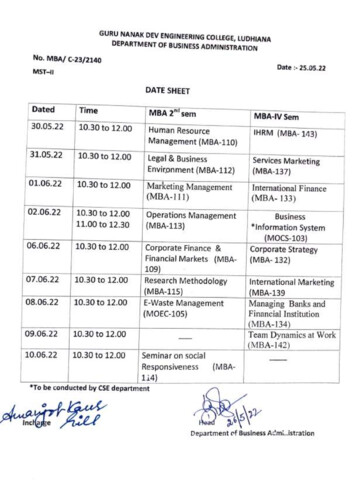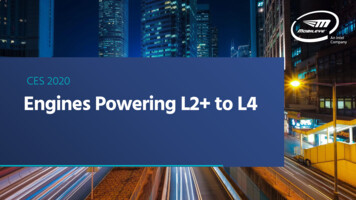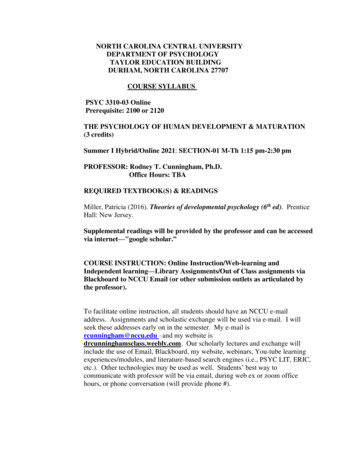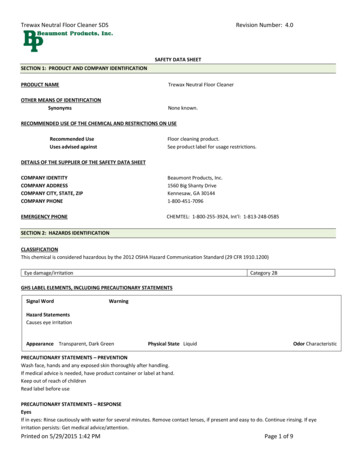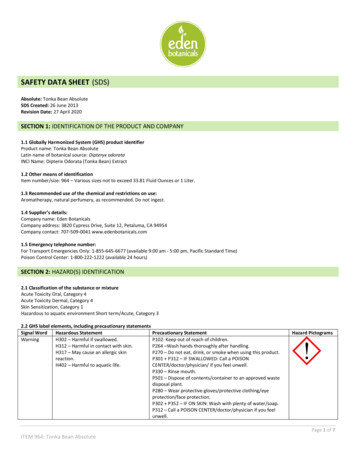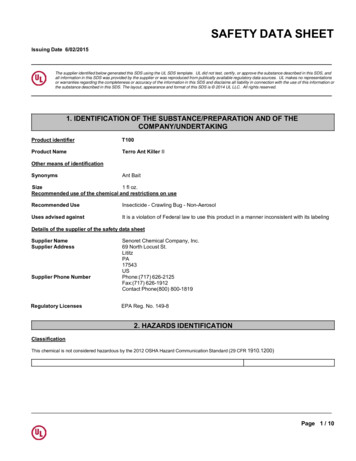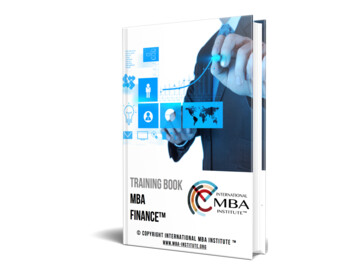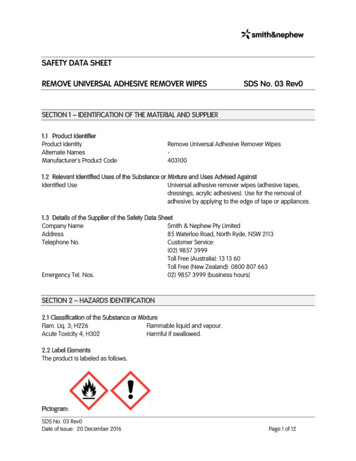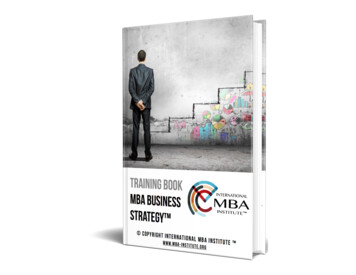
Transcription
MBA Building Supplies SDS SheetSection 1 – IdentificationProduct Identifier used on Label: Sheet steel.Use/Description: Sheet steel for thin gauge framing products.Products: Cold-Formed Steel Framing components and accessories for drywall, curtain wall and load bearing systems.Synonyms: Hot Band, Cold Rolled, P&O, Galvanized.Company Identification and Emergency Contact Information:MBA BUILDING SUPPLIES, INC.2200 Tempel DriveLibertyville IL 60048Phone: 847-680-7773Fax: , ILFrackville, PARainbow City, ALDallas, TXSection 2 – Hazard(s) IdentificationClassification of the chemical: Sheet steel is considered an article under Reach regulation (REACH REGULATION (EC) No 1907/2006) and is notsubject to classification under CLP regulation (REGULATION (EC) No 1272/2008). However, Sheet steel is not exempt as an article under OSHA'sHazard Communication Standard (29 CFR 1910.1200) due to its downstream use, thus this product is considered a mixture and a hazardous material.Therefore, the categories of Health Hazards as defined in “GLOBALLY HARMONIZED SYSTEM OF CLASSIFICATION AND LABELLING OFCHEMICALS (GHS), Third revised edition ST/SG/AC.10/30/Rev.3” United Nations, New York and Geneva, 2009 have been evaluated. Refer to Section3, 8 and 11 for additional information.Signal word, hazard statement(s), symbols and precautionary statement(s):HazardSymbolSignalWordHazard ClassificationCarcinogenicity - 2Reproductive Toxicity - 2Single Target OrganToxicity (STOT) RepeatExposure -1DangerAcute Toxicity-Oral - 4Skin Sensitization - 1STOT Single Exposure - 3NAHazard Statement(s)Suspected of causing cancer.Suspected of damaging fertility or the unborn child.Causes damage to lungs and central nervous system throughprolonged or repeated inhalation exposure.Harmful if swallowed.May cause an allergic skin reaction.Harmful in contact with skin.May cause respiratory irritation.Causes eye irritation.Eye Irritation-2BPrecautionary Statement(s):PreventionDo not breathe dusts / fume / gas / mist / vapor /spray. Wear protective gloves / protective clothing /eye protection / face protection.Contaminated work clothing must not be allowed outof the workplace.Use only outdoors or in well ventilated areas.Wash thoroughly after handling.Obtain special instructions before use.Do not handle until all safety precautions havebeen read and understood.Do not eat, drink or smoke when using thisproduct.Hazards not otherwise classified: None KnownResponseStorage/DisposalIf inhaled: Remove person to fresh air and keepcomfortable for breathing.If exposed, concerned or feel unwell: Get medicaladvice/attention.If in eyes: Rinse cautiously with water for severalminutes. Remove contact lenses, if present and easy todo. Continue Rinsing.If on skin: Wash with plenty of water. If irritation or rashoccurs: Get medical advice/attention. Take off and washcontaminated clothing before reuse.Call a poison center/doctor if you feel unwell.Dispose of contents inaccordance with federal, state andlocal regulations.Unknown acute toxicity statement (mixture): None Known
Section 3 – Composition/Information on IngredientsMixturesChemical nameCAS NumberWeight e7439-96-50.0-1.35Nickel7440-02-00-0.2This product is an alloy. At temperatures above the melting point steel products may liberate fumes containing oxides of iron and alloying elements.Composition Comments: All concentrations are in percent by weight unless ingredient is a gas. Gas concentrations are in percent by volume. Productcontains less than 0.004% cadmium and less than 0.01% lead, mercury, hexavalent, chromium, antimony, polybrominated biphenyls (PBB) andpolybrominated diphenyl ethers (PBDE).Section 4 – First-aid MeasuresEye Contact- In case of overexposure to dusts, immediately flush eyes with plenty of water for at least 15 minutes occasionally lifting the eye lids. Getmedical attention if irritation persists.Skin Contact - In case of overexposure to dusts or particulates, wash with soap and plenty of water. Get medical attention if irritation develops orpersists.Inhalation - In case of overexposure to dusts, remove to fresh air. Get immediate medical attention if symptoms worsen.Ingestion - If excessive amounts of dust or particulates are swallowed, treat symptomatically. Get medical attention.Section 5 – Fire-fighting MeasuresExtinguishing Techniques-Steel products do not present fire hazards. Not applicable.Any non-oxidized fine metal particles/ dust generated by grinding, sawing, abrasive blasting, or individual customer processes may produce materialsthat the customer should test for combustibility and other hazards in accordance with applicable regulations. High concentrations of combustible metallicfines in the air may present an explosion hazard.Section 6 - Accidental Release MeasuresReleased material precautions: Not Applicable for Sheet steel as sold/shipped. For spills involving finely divided particles, clean-up personnelshould be protected against contact with eyes and skin. Avoid inhalation of dust.Methods and materials of containment and clean up: Not Applicable for Sheet steel as sold/shipped. Fine turnings and small chips should beswept or vacuumed and placed into appropriate disposable containers. Please recycle when appropriate.Section 7 - Handling and StorageHandling precautions-Do not handle without appropriate safety apparel and/or devices.Storage-Store away from strong oxidizers, acids, or incompatible products.Section 8 - Exposure Controls / Personal ProtectionOperations with potential for producing high concentrations of airborne particulates or fumes should be evaluated and measured as necessary.Eye Protection - Use safety glasses. Dust resilient safety goggles are recommended under circumstances where particles could cause injury such asgrinding or cutting. Face shield should be used when welding or cutting.Skin - Appropriate protective gloves should be worn as necessary. Good personal hygiene practices should be followed including cleansing exposed skinseveral times daily with soap and water, and laundering or dry cleaning soiled work clothing.Respiratory Protection - NIOSH/MSHA approved dust/fume/mist respirator should be used to avoid excessive exposure. See Section 3 for componentmaterial information exposure limits. If such concentrations are sufficiently high that this respirator is inadequate, or high enough to cause oxygendeficiency, use a positive pressure self-contained breathing apparatus (SCBA). Follow all applicable respirator use, fitting, and training standards andregulations.Ventilation - Provide general and/or local exhaust ventilation to control airborne levels of dust or fumes below exposure limits.Exposure Guidelines - No permissible exposure limits (PEL) or threshold limit values (TLV) exist for steel. See Section 3 for component materials.Some grades of steel will contain different combinations of these elements. Trace elements may also be present in minute amounts.Pag e 2 5
Section 9 - Physical and Chemical PropertiesAppearance and Odor – Silver grey to grey black with metallic luster.Boiling Point - Not applicableMelting Point - Approximately 2800 oFpH - Not applicableSpecific Gravity (at 15.6oC) - Not applicableDensity (at 15.6 oC) - Not applicableVapor Pressure - Not applicableVapor Density (air 1) - Not applicable% Volatile, by Volume - Not applicableSolubility in Water - Insoluble.Evaporation Rate (Butyl Acetate 1) - Not applicableOther Physical and Chemical Data - NoneSection 10 - Stability and ReactivityReactivity: under normal conditions of use, the storage and transportation of this product is stable.Chemical Stability: Steel products are stable under normal storage and usage conditions.Possibility of hazardous reaction: None KnownConditions to Avoid: Storage with strong acids or incompatible materials.Incompatible Materials: Strong acidsHazardous Decomposition Products: Metal oxides.Section 11 - Toxicological InformationThe following toxicity data has been determined for Sheet steel when further processed using the information available for its components applied tothe guidance on the preparation of an SDS under the GHS requirements of OSHA and the EU CPL:Hazard CategoryHazard ClassificationSignal WordHazard StatementWarningDangerous if swallowed.WarningCauses eye irritation.1dWarningMay cause an allergic skin reaction.NA2gWarningAs a solid product, it is not classified as a carcinogen.NA2hWarningSuspected of harm with fertility or the unborn child.NA3iWarningMay cause respiratory irritation.NA1jDangerCan cause damage to lungs and central nervoussystem through sustained or repeatedinhalation exposure.EUOSHANA4aNA2BcSkin/Dermal Sensitization(covers Category 1)NACarcinogenicity (covers Categories 1A,1B and 2)Toxic Reproduction (covers Categories1A, 1B and 2)Acute Toxicity Hazard (coversCategories 1-4)Eye Damage/ Irritation (coversCategories 1, 2A and 2B)Specific Target Organ Toxicity(STOT) Following Single Exposure(covers Categories 1-3)STOT following Repeated Exposure(covers Categories 1 and 2)HazardSymbolsNo PictogramPag e 3 5
Toxicological data listed below are presented regardless to classification criteria. Individual hazard classification categories where the toxicologicalinformation has met or exceeded a classification criteria threshold are listed above.a. No LC50 or LD50 has been established for Sheet steel. The following data has been determined for the components: Iron: Rat LD50 98.6 g/kg (REACH)Rat LD50 1060 mg/kg (IUCLID)Rat LD50 984 mg/kg (IUCLID)Rabbit LD50 890 mg/kg (IUCLID)Guinea Pig LD50 20 g/kg (TOXNET) Nickel: LD50 9000 mg/kg (Oral/Rat) Silicon: LD50 3160 mg/kg (Oral/Rat) Manganese: Rat LD50 2000 mg/kg (REACH)Rat LD50 9000 mg/kg (NLM Toxnet)Information on likely routes of exposure:Ingestion: Solid steel: Not applicable, due to the form of the product. However, ingestion of dusts generated in working operations may cause nausea andvomiting.Inhalation: No inhalation hazard under normal conditions. Welding, burning, sawing, brazing, grinding or machining operations may produce fumes anddusts of metal oxides. High absorptions of freshly formed fumes/dusts of metal oxides can produce signs of metal fume illness. Typical symptoms last 12to 48 hours and are characterized by metallic taste in the mouth, dryness, and irritation of the throat, followed by weakness, muscle pain, fever, and chills.Skin contact: Under normal conditions of intended use, this material does not pose a risk to health. Dust may irritate skin. Contact with hot material cancause thermal burns which may result in permanent damage.Eye contact: Under normal conditions of intended use, this product does not pose a risk to health. Contact with scorching material can cause thermalburns which may result in permanent damage. Grinding and sanding this product may generate particles that may irritate the eyes. Symptoms includeitching, burning, redness, and tearing of eyes.Section 12 - Ecological InformationEcotoxicity Not expected to be harmful to aquatic organisms.Components Species Test ResultsIron (CAS 7439-89-6)AquaticFish LC50 Channel catfish (Ictalurus punctatus) 500 mg/l, 96 hoursNickel (CAS 7440-02-0)AquaticFish LC50 Fathead minnow (Pimephales promelas) 2.916 mg/l, 96 hoursZinc (CAS 7440-66-6)AquaticFish LC50 Rainbow trout,donaldson trout 0.24 mg/l, 96 hours(Oncorhynchus mykiss)Persistence and degradability No data available.Bioaccumulative potential No data available on bioaccumulation.Mobility in soil Not available.Mobility in general Not relevant, due to the form of the product.Other adverse effects None known.Section 13 - Disposal ConsiderationsRecycle, rather than disposal, should be the definitive goal of handling efforts. Dispose in accordance with federal, state, and local health andenvironmental regulations. Prevent materials from entering drains, sewers, or waterways.Section 14 - Transport InformationDOTNot regulated as dangerous goods.IATANot regulated as dangerous goods.IMDGNot regulated as dangerous goods.Transport in bulk according to Annex II of MARPOL 73/78 and the IBC CodeNot applicable.Pag e 4 5
Section 15 - Regulatory InformationThis product is not hazardous under the criteria of the Federal OSHA Hazard Communication Standard 29 CFR 1910.1200. However, dusts and fumesfrom this product may be combustible or hazardous and require protection to comply with applicable Federal, state and local laws and regulations.California Proposition 65: This product contains chemicals (antimony [oxide], arsenic, beryllium, chromium [hexavalent], cobalt, cadmium, lead,nickel) known to the State of California to cause cancer and chemicals (cadmium, lead) known to the State of California to cause birth defects or otherreproductive harm.Massachusetts Substance List: Aluminum, Antimony, Arsenic, Beryllium, Boron, Cadmium, Chromium, Cobalt, Copper, Hydrochloric acid, Lead,Magnesium, Manganese, Molybdenum, Nickel, Nitrogen, Phosphorus, Selenium, Silicon, Sulfur, Tin, Titanium, Tungsten, Vanadium, ZincPennsylvania Hazardous Substance List: Aluminum, Antimony, Arsenic, Beryllium, Boron, Cadmium, Chromium, Cobalt, Copper, Hydrochloricacid, Lead, Magnesium, Manganese, Molybdenum, Nickel, Nitrogen, Phosphorus, Selenium, Silicon, Sulfur, Tin, Titanium, Tungsten, Vanadium, ZincNew Jersey Hazardous Substance List: Aluminum, Antimony, Arsenic, Beryllium, Boron, Cadmium, Chromium, Cobalt, Copper, Hydrochloric acid,Lead, Magnesium, Manganese, Molybdenum, Nickel, Nitrogen, Phosphorus, Selenium, Silicon, Sulfur, Tin, Titanium, Tungsten, Vanadium, ZincToxic Substances Control Act (TSCA)Components of this product are listed on the TSCA Inventory.Comprehensive Environmental Response, Compensation and Liability Act (CERCLA)Steel is not reportable, however, it contains hazardous substances that may be reportable if released in pieces with diameters less than or equal to 0.004inches (RQ marked with a “*”).Sheet SteelChemical eadNickelPhosphorusSeleniumZincReportable Quantity (in lb)5000*1*10*10*5000*5000*10*100*1100*1000*Section 16 - Other InformationRevision date November 25, 2015Version # 01This SDS covers MBA BUILDING SUPPLIES product as delivered from the MBA BUILDING SUPPLIES facilities, but does not include chemicalsthat may be applied by subsequent handlers and/or distributors of this product. This could include a variety of materials including oils, paints, etc. thatare not included in this SDS. During welding, precautions should be taken for airborne contaminants that may originate from components of the weldingrod. Arc or spark generated when welding or burning could be a source of ignition for combustible and/or flammable materials.Disclaimer This information is provided without warranty. The information is believed to be correct. This information should be used to make anindependent determination of the methods to safeguard workers and the environment. The information in this Safety Data Sheet (SDS) was obtainedfrom sources which we believe are reliable; however, the information is provided without any representation or warranty, expressed or implied,regarding the accuracy or correctness. The conditions or methods of handling, storage, use and disposal of the product are beyond our control and maybe beyond our knowledge. For this and other reasons, we do not assume responsibility and expressly disclaim liability for loss, damage, or expensearising out of or in any way connected with the handling, storage, use, or disposal of this product.Pag e 5 5
MBA BUILDING SUPPLIES, INC. 2200 Tempel Drive Libertyville IL 60048 Phone: 847-680-7773 Fax: 847-680-7883 www.mbastuds.com Locations: Libertyville, IL Frackville, PA Rainbow City, AL Dallas, TX Section 2 - Hazard(s) Identification Classification of the chemical: Sheet steel is considered .

